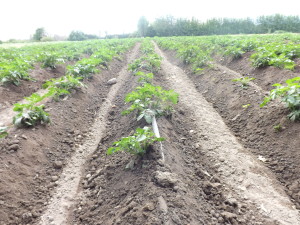Doing more with less water
The question we have been asked more this year than any other is “What are you doing on the farm to cope with the drought?” We have actually been planning for it ever since last winter when it became obvious that the snow pack was not dense enough to last.
Nash’s team estimated that the irrigation system would remain on until the middle of the summer, and then the various irrigation districts would shut down to keep the required minimum of 60 cfs of water in the Dungeness for the salmon. Normally, the shutdown comes in the middle of September, when the salmon are ready to launch themselves up the river to spawn. But this year is different.
Knowing we would have to raise crops without much water this year, we cut down on our vegetable production. We are raising enough for the Farm Share program, the farmers markets and our Farm Store, but not for our wholesale accounts. This means we have about half the acreage in veggies than normal. We also have put the vegetables for later in the year in fields that have adequate wells, and are now in the process of hooking up drip tape to many of these crops. Some crops don’t lend themselves to drip systems, like fava beans or grain. But others, like Brussels sprouts or potatoes (above) work well due to their spacing and water requirements.
Drip systems are so common in California that farmers there take them for granted. But we have been spoiled with our wonderful climate and mountain snow pack that provided great irrigation water every year for decades. We have used drip tape on occasion, but now we will work with it seriously to use it effectively on a regular basis. To that end, we will roll it up to reuse it again next year, should the drought continue.

